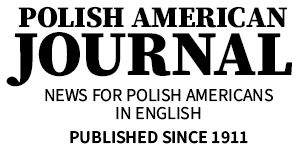
The PAJ is the nation's largest, independent English language newspaper dedicated to the promotion, preservation and continuance of Polish American culture. It is published by Panagraphics, Inc., in Buffalo, New York. The PAJ has readers throughout the world. It is the most referenced Polish American publication in The Congressional Record.
Among the PAJ editors, columnists and writers are some of American Polonia’s most respected personalities. Since it’s founding in 1911, Polish American political, religious, fraternal, social and entertainment leaders have staffed the newspaper.
The Polish American Journal was founded in October 1911, as a small Polish-language newspaper, Zorza (The Dawn), in Pittston, Pa. Ignatius Haduch was its editor.
Two years later, Zorza was renamed Republika and moved to Wilkes-Barre, Pa., where it was published until 1918; its editor then moved to Scranton, home to another Polish language weekly, Górnik Pennsylwanski (The Pennsylvania Miner). The Miner was published by a non-Pole.
Both papers were experiencing financial difficulties, and were saved from suspension by the appearance of the late John Dende. Although a comparatively recent arrival in the United States, he had already made his mark on the Polonias of Scranton and Wilkes-Barre. John Dende first purchased the Republika, and in 1920, the Górnik Pennsylwanski. He combined the two under the title of Republika-Górnik Pennsylwanski (Republic-Miner of Pennsylvania).
The paper soon became influential throughout the hard coal fields, and its editorial views were often quoted in Polish publications in other parts of the country. John Dende became a national figure in Polish American circles, traveling extensively to attend important affairs conducted in the interest of Americans of Polish origin.
John Dende died December 18, 1944, and the newspaper continued to be published by his sons.
On January 25, 1948, the paper, under the name of Polish American Journal, became the first Polish American weekly to be printed entirely in the English language. At that time, the decision was met with disapproval from other editors who continued to print Polish-only papers.
The change from Polish to English was motivated by the then six million Americans of Polish descent, five million of whom were American-born and better versed in English. The move was the right one, as evidenced by an increase in circulation of a thousand percent over the Republika-Górnik. Moreover, the Polish American Journal acquired a national stature as it became the only national English language voice of Americans of Polish ancestry.
The Polish American Journal became the only Polish American publication that had established direct contacts with members of Congress, government officials, national civic and political leaders, the leaders of Free Poles here and abroad, and with numerous anti-Communist crusaders throughout the world.
As the Journal approached the 1980s, the Dende brothers—Henry and Richard—began to entertain thoughts of retirement and the pursuit other activities they had been interested in. Henry was especially concerned that before Dende Press closed its doors, a new home for the Journal had to be found. Across the nation, Polish American publications were closing upon the retirement of their publishers.
In 1979, a group of young, Polish American college graduates in Buffalo, New York, invested their limited income in what was considered to be an up and coming part of an increasingly specialized industry: computerized typesetting. They formed Panagraphics Corporation and began publishing a Polish American newspaper, the Polonia Reporter under the auspices of the Polish Union of America. News of the new Polish pope and the fledgling Solidarity movement filled the pages of the paper.
When the PUA decided to limit its news to strictly fraternal activities, Panagraphics decided to start its own publication. The new paper was called the Polish American Voice. Henry Dende was watching these developments from Scranton, and, after several meetings, decided that the PAJ should begin publishing in Buffalo with the premier issue being August 1983.
Panagraphics published both the Voice and the Journal as separate newspapers. However, to avoid both dual subscriptions and duplication of news in each, they decided to merge the publications. The result was the expanded Polonia’s Voice: The Polish American Journal.
In April of 1991, the PAJ and Panagraphics moved its office to new modern facilities at 1275 Harlem Road on the Buffalo/Cheektowaga border. It was published there until September 2002, when it moved to the growing Buffalo suburb of Boston, an area settled at the turn of the 20th century by immigrant Polish farmers. At that time, the decision was made to join the ever-increasing business practice of e-commerce. Thanks to the internet, the entire paper is now written, composed and edited by writers and staff in locations throughout the United States and Poland.
The PAJ has been witness to many changes, and has continued to adapt to these changes in a fashion that has always brought the paper new opportunities to serve the country’s Polish American community. This, coupled with events in a free, democratic Poland, have created a demand for the paper that has not been seen in many years.
Since its founding, the Polish American Journal has been dedicated to the promotion and continuation of Polish American culture in the United States, a heritage rich in the joys of the family, church and country.

